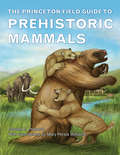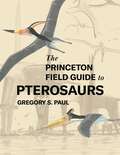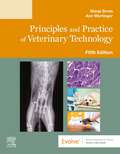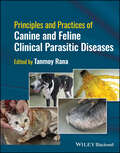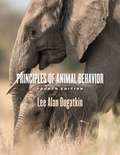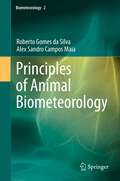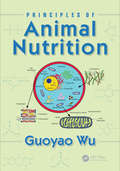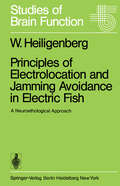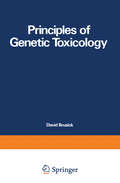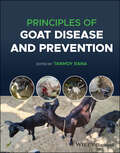- Table View
- List View
The Princeton Field Guide to Mesozoic Sea Reptiles
by Gregory S. PaulAn authoritative illustrated guide to the mighty reptiles that dominated the seas of the Mesozoic for 185 million yearsNew discoveries are revealing that many ancient oceangoing reptiles were energetic animals capable of inhabiting an array of watery habitats and climates, including polar winters. The Princeton Field Guide to Mesozoic Sea Reptiles provides the most up-to-date and comprehensive coverage of the great Mesozoic groups that commanded the seas for tens of millions of years. This incredible field guide covers 435 species and features stunning illustrations of swimming reptiles ranging in size from little lizards to others with great necks longer than their bodies. It discusses the history of sea reptiles through 185 million years of the Mesozoic, their anatomy, physiology, locomotion, reproduction and growth, and extinction, and even gives a taste of what it might be like to travel back to the Mesozoic. This one-of-a-kind guide also challenges the common image of these reptiles as giants of the prehistoric waters, showing how the largest weighed far less than today’s biggest whales.Features detailed species accounts of 435 different kinds of sea reptiles, with the latest size and mass estimatesWritten and illustrated by the acclaimed researcher and artist who helped to redefine our understanding of dinosaur anatomyDescribes placodonts, plesiosaurs, ichthyosaurs, mosasaurs, sea snakes, sea turtles, marine crocs, and moreCovers everything from biology to the colorful history of sea reptile paleontologyIncludes dozens of original skeletal drawings and full-color life scenes
The Princeton Field Guide to Prehistoric Mammals
by Donald R. Prothero Mary Persis WilliamsAfter the mass extinction of the dinosaurs 65 million years ago, mammals became the dominant terrestrial life form on our planet. Roaming the earth were spectacular beasts such as saber-toothed cats, giant mastodonts, immense ground sloths, and gigantic giraffe-like rhinoceroses. Here is the ultimate illustrated field guide to the lost world of these weird and wonderful prehistoric creatures.A woolly mammoth probably won't come thundering through your vegetable garden any time soon. But if one did, this would be the book to keep on your windowsill next to the binoculars. It covers all the main groups of fossil mammals, discussing taxonomy and evolutionary history, and providing concise accounts of the better-known genera and species as well as an up-to-date family tree for each group. No other book presents such a wealth of new information about these animals—what they looked like, how they behaved, and how they were interrelated. In addition, this unique guide is stunningly illustrated throughout with full-color reconstructions of these beasts—many never before depicted—along with photographs of amazing fossils from around the world.Provides an up-to-date guidebook to hundreds of extinct species, from saber-toothed cats to giant mammoths Features a wealth of color illustrations, including new reconstructions of many animals never before depictedDemonstrates evolution in action—such as how whales evolved from hoofed mammals and how giraffes evolved from creatures with short necksExplains how mass extinctions and climate change affected mammals, including why some mammals grew so huge
The Princeton Field Guide to Pterosaurs (Princeton Field Guides #155)
by Gregory S. PaulThe most up-to-date and authoritative illustrated guide to the marvelous flying reptiles that dominated the skies of the Mesozoic for 160 million yearsOnce seen by some as evolutionary dead-enders, pterosaurs were vigorous winged reptiles capable of thriving in an array of habitats and climates, including polar winters. The Princeton Field Guide to Pterosaurs transforms our understanding of these great Mesozoic archosaurs of the air. This incredible guide covers 115 pterosaur species and features stunning illustrations of pterosaurs ranging in size from swallows to small sailplanes, some with enormous, bizarre head crests and elongated beaks. It discusses the history of pterosaurs through 160 million years of the Mesozoic—including their anatomy, physiology, locomotion, reproduction, growth, and extinction—and even gives a taste of what it might be like to travel back to the Mesozoic. This one-of-a-kind guide also challenges the common image of big pterosaurs as ultralights that only soared, showing how these spectacular creatures could be powerful flappers as heavy as bears.Features detailed species accounts of 115 different kinds of pterosaurs, with the latest size and mass estimatesWritten and illustrated by the acclaimed researcher and artist who helped to redefine the anatomy and flight performance of pterosaursCovers everything from pterosaur biology to the colorful history of pterosaur paleontologyIncludes dozens of original skeletal drawings and full-color life studies
Principles and Practice of Veterinary Technology - E-Book
by Margi SiroisPrepare for veterinary technician credentialing examinations and clinical practice with Principles and Practice of Veterinary Technology, 4th Edition. Reorganized and updated with the latest advances in the field, this comprehensive text helps you develop strong critical thinking and independent work skills. It includes expanded coverage of complementary medicine, critical care, pet health insurance, and toxicology. More than 80 step-by-step procedures throughout the text emphasize your roles and responsibilities for all AVMA-required psychomotor techniques. Plus, dozens of summary tables and boxes make it easy to find key information.Updated companion site with varying questions provide you with additional modes of study.Step-by-step procedures help you learn the essential skills required to become a successful veterinary technician. Summary tables and boxes condense key information to make complex material easier to understand. Clinical discussion of the role of the technician allows you to focus on your responsibilities in every aspect of practice. NEW! Expanded coverage of complementary medicine, critical care, pet health insurance, and toxicology reflect advances in veterinary technology.NEW! Review questions throughout text help you to understand and retain core concepts.
Principles and Practice of Veterinary Technology - E-Book
by Ann WortingerDevelop strong critical thinking and independent work skills! Principles and Practice of Veterinary Technology, 5th Edition features more than 80 illustrated, step-by-step procedures that emphasize the technician’s roles and responsibilities for all AVMA-required psychomotor techniques. This edition includes expanded coverage of complementary medicine, critical care, pet health insurance, and toxicology. Plus, dozens of summary tables and boxes make it easy to find key information. Step-by-step procedures include instructions for all AVMA-required psychomotor techniques, presenting complex procedures clearly and preparing you to master the essential skills required to become a successful veterinary technician. Clinical discussions clearly delineate the technician’s role, enabling you to focus on your roles and responsibilities in every aspect of practice. Summary tables and boxes throughout the text condense complex, vital information, drawing your attention to key information and making it easy to understand. Thoroughly updated content throughout, including major updates to anesthesia, pain management, critical care, and infectious disease, provides the most up-to-date information in these critical areas.
Principles and Practices of Canine and Feline Clinical Parasitic Diseases
by Tanmoy RanaPrinciples and Practices of Canine and Feline Clinical Parasitic Diseases A comprehensive reference guide for specialists highlighting the parasitic diseases of dogs and cats with appropriate therapeutic strategy Parasitic diseases are a scourge for dogs and cats, and the impact of the numerous maladies associated with these diseases cannot be underestimated. For the clinician or researcher attempting to alleviate these symptoms, Principles and Practices of Canine and Feline Clinical Parasitic Diseases is a helpful, introductory practical guidebook that helps identify the parasites infecting these animals and suggests useful treatment strategies based on an appropriate diagnosis. Principles and Practices of Canine and Feline Clinical Parasitic Diseases comprehensively details its topic from symbiosis and parasitism, to therapeutics measures and control strategies, to the deleterious effect of parasites in various organs in dogs and cats. The book offers extensive information on management approaches, the most significant clinical findings, diagnostic approaches, disease prevention, and drug evaluation. As a reference, the guide provides systems for the identification of the pathogens and recognizes the severity and exhibition of disease manifestation. Principles and Practices of Canine and Feline Clinical Parasitic Diseases readers will also find: Preventative measures that can be utilized to prophylactically assure the continued health of the patient Chapters written by contributors with specialized knowledge in each particular subject presented The most up-to-date advanced research in the field of parasitic diseases Each chapter covers treatment schedules, details about the disease, and a management approach, using figures and line figures to aid in identification and treatment Principles and Practices of Canine and Feline Clinical Parasitic Diseases is ideal for undergraduates, postgraduates, researchers, academics, and industrialists interested in the various parasitic diseases and treatments. It is also extremely useful as a ready reference for scientists seeking to develop new anti-parasitic drugs.
Principles and Practices of Canine and Feline Clinical Parasitic Diseases
by Tanmoy RanaPrinciples and Practices of Canine and Feline Clinical Parasitic Diseases A comprehensive reference guide for specialists highlighting the parasitic diseases of dogs and cats with appropriate therapeutic strategy Parasitic diseases are a scourge for dogs and cats, and the impact of the numerous maladies associated with these diseases cannot be underestimated. For the clinician or researcher attempting to alleviate these symptoms, Principles and Practices of Canine and Feline Clinical Parasitic Diseases is a helpful, introductory practical guidebook that helps identify the parasites infecting these animals and suggests useful treatment strategies based on an appropriate diagnosis. Principles and Practices of Canine and Feline Clinical Parasitic Diseases comprehensively details its topic from symbiosis and parasitism, to therapeutics measures and control strategies, to the deleterious effect of parasites in various organs in dogs and cats. The book offers extensive information on management approaches, the most significant clinical findings, diagnostic approaches, disease prevention, and drug evaluation. As a reference, the guide provides systems for the identification of the pathogens and recognizes the severity and exhibition of disease manifestation. Principles and Practices of Canine and Feline Clinical Parasitic Diseases readers will also find: Preventative measures that can be utilized to prophylactically assure the continued health of the patient Chapters written by contributors with specialized knowledge in each particular subject presented The most up-to-date advanced research in the field of parasitic diseases Each chapter covers treatment schedules, details about the disease, and a management approach, using figures and line figures to aid in identification and treatment Principles and Practices of Canine and Feline Clinical Parasitic Diseases is ideal for undergraduates, postgraduates, researchers, academics, and industrialists interested in the various parasitic diseases and treatments. It is also extremely useful as a ready reference for scientists seeking to develop new anti-parasitic drugs.
Principles and Practices of DNA Analysis: A Laboratory Manual for Forensic DNA Typing (Springer Protocols Handbooks)
by Surajit Das Hirak Ranjan Dash Pankaj ShrivastavaThe book presents hands-on protocols for conventional and advanced forensic DNA fingerprinting experiments. It includes manual, semi-automatic, and advanced automatic techniques for DNA extraction from different biological samples.It also discusses various qualitative and quantitative approaches for the assessment of extracted forensic DNA. It contains protocols for the amplification of short tandem repeat markers (STRs) for the amplification-based target enrichment of the forensic samples.Further, it examines genotyping of the STR loci through capillary electrophoresis and includes real-world case studies where forensic DNA analysis has been used in the criminal and civil disputes. The book concludes by presenting technological developments in the field of DNA forensic analysis. Suitable for beginners, it is a key reference resource on a wide variety of DNA profiling techniques and applications.
Principles for Evaluation of One Health Surveillance: The EVA Book
by Marisa Peyre François Roger Flavie GoutardThis book outlines essential elements of the evaluation of health surveillance within the One Health concept. It provides an introduction to basic theoretical notions of evaluation and vividly discusses related challenges. Expert authors cover the entire spectrum of available, innovative methods, from those for system process evaluations to methods for the economic evaluation of the surveillance strategies. Each chapter provides a detailed description of the methodology required and the tools available as illustrated by practical examples of animal health or One Health surveillance evaluations in both developed and developing countries.Targeting not only scientists, including epidemiologists, but also technical advisers of decision-makers, the present work is suitable for the evaluation of any type of health surveillance system - animal, human or combined - regardless of the socio-economic context. The volume is richly equipped with practical tools and examples, which enables the reader to apply the methods described. Increasing importance of health surveillance, and threats from disease outbreaks such as the coronavirus pandemic, underline the practical relevance of this work, which will fill an important gap in the literature.
Principles of Animal Behavior, 4th Edition
by Lee Alan DugatkinSince the last edition of this definitive textbook was published in 2013, much has happened in the field of animal behavior. In this fourth edition, Lee Alan Dugatkin draws on cutting-edge new work not only to update and expand on the studies presented, but also to reinforce the previous editions’ focus on ultimate and proximate causation, as well as the book’s unique emphasis on natural selection, learning, and cultural transmission. The result is a state-of-the-art textbook on animal behavior that explains underlying concepts in a way that is both scientifically rigorous and accessible to students. Each chapter in the book provides a sound theoretical and conceptual basis upon which the empirical studies rest. A completely new feature in this edition are the Cognitive Connection boxes in Chapters 2–17, designed to dig deep into the importance of the cognitive underpinnings to many types of behaviors. Each box focuses on a specific issue related to cognition and the particular topic covered in that chapter. As Principles of Animal Behavior makes clear, the tapestry of animal behavior is created from weaving all of these components into a beautiful whole. With Dugatkin’s exquisitely illustrated, comprehensive, and up-to-date fourth edition, we are able to admire that beauty anew.
Principles of Animal Behavior, 4th Edition
by Lee Alan DugatkinSince the last edition of this definitive textbook was published in 2013, much has happened in the field of animal behavior. In this fourth edition, Lee Alan Dugatkin draws on cutting-edge new work not only to update and expand on the studies presented, but also to reinforce the previous editions’ focus on ultimate and proximate causation, as well as the book’s unique emphasis on natural selection, learning, and cultural transmission. The result is a state-of-the-art textbook on animal behavior that explains underlying concepts in a way that is both scientifically rigorous and accessible to students. Each chapter in the book provides a sound theoretical and conceptual basis upon which the empirical studies rest. A completely new feature in this edition are the Cognitive Connection boxes in Chapters 2–17, designed to dig deep into the importance of the cognitive underpinnings to many types of behaviors. Each box focuses on a specific issue related to cognition and the particular topic covered in that chapter. As Principles of Animal Behavior makes clear, the tapestry of animal behavior is created from weaving all of these components into a beautiful whole. With Dugatkin’s exquisitely illustrated, comprehensive, and up-to-date fourth edition, we are able to admire that beauty anew.
Principles of Animal Behavior, 4th Edition
by Lee Alan DugatkinSince the last edition of this definitive textbook was published in 2013, much has happened in the field of animal behavior. In this fourth edition, Lee Alan Dugatkin draws on cutting-edge new work not only to update and expand on the studies presented, but also to reinforce the previous editions’ focus on ultimate and proximate causation, as well as the book’s unique emphasis on natural selection, learning, and cultural transmission. The result is a state-of-the-art textbook on animal behavior that explains underlying concepts in a way that is both scientifically rigorous and accessible to students. Each chapter in the book provides a sound theoretical and conceptual basis upon which the empirical studies rest. A completely new feature in this edition are the Cognitive Connection boxes in Chapters 2–17, designed to dig deep into the importance of the cognitive underpinnings to many types of behaviors. Each box focuses on a specific issue related to cognition and the particular topic covered in that chapter. As Principles of Animal Behavior makes clear, the tapestry of animal behavior is created from weaving all of these components into a beautiful whole. With Dugatkin’s exquisitely illustrated, comprehensive, and up-to-date fourth edition, we are able to admire that beauty anew.
Principles of Animal Behavior, 4th Edition
by Lee Alan DugatkinSince the last edition of this definitive textbook was published in 2013, much has happened in the field of animal behavior. In this fourth edition, Lee Alan Dugatkin draws on cutting-edge new work not only to update and expand on the studies presented, but also to reinforce the previous editions’ focus on ultimate and proximate causation, as well as the book’s unique emphasis on natural selection, learning, and cultural transmission. The result is a state-of-the-art textbook on animal behavior that explains underlying concepts in a way that is both scientifically rigorous and accessible to students. Each chapter in the book provides a sound theoretical and conceptual basis upon which the empirical studies rest. A completely new feature in this edition are the Cognitive Connection boxes in Chapters 2–17, designed to dig deep into the importance of the cognitive underpinnings to many types of behaviors. Each box focuses on a specific issue related to cognition and the particular topic covered in that chapter. As Principles of Animal Behavior makes clear, the tapestry of animal behavior is created from weaving all of these components into a beautiful whole. With Dugatkin’s exquisitely illustrated, comprehensive, and up-to-date fourth edition, we are able to admire that beauty anew.
Principles of Animal Biometeorology (Biometeorology #2)
by Roberto Gomes da Silva Alex Sandro Campos MaiaThe book begins by describing in detail the mechanisms of energy exchange – radiative, convective, conductive and evaporative – together with techniques for their determination. The discussion extends to the importance of CO2, ozone and methane, together with that of aerosol pollutants and the evolution of atmospheric CO2. Subsequent chapters apply the results of the biophysical methods to mammals, birds and aquatic animals. Discussion includes problems of shelter and shade for animals in tropical environments and techniques for the thermal evaluation for shelters and for several tree types. The details of heat exchange between animals and the environment are presented, in separate chapters covering Mammals and Birds and Aquatic Mammals. A chapter on Shade and Shelter describes the importance of shade for animals, factors of shade efficiency, the protections offered by shelter and methods of calculating the protection afforded by both shade and shelter. A Special Methods chapter offers a variety of techniques for evaluating cutaneous and respiratory evaporation, and practical methods for sampling of hairs and the evaluation of hair coat characteristics.
Principles of Animal Nutrition
by Guoyao WuAnimals are biological transformers of dietary matter and energy to produce high-quality foods and wools for human consumption and use. Mammals, birds, fish, and shrimp require nutrients to survive, grow, develop, and reproduce. As an interesting, dynamic, and challenging discipline in biological sciences, animal nutrition spans an immense range from chemistry, biochemistry, anatomy and physiology to reproduction, immunology, pathology, and cell biology. Thus, nutrition is a foundational subject in livestock, poultry and fish production, as well as the rearing and health of companion animals. This book entitled Principles of Animal Nutrition consists of 13 chapters. Recent advances in biochemistry, physiology and anatomy provide the foundation to understand how nutrients are utilized by ruminants and non-ruminants. The text begins with an overview of the physiological and biochemical bases of animal nutrition, followed by a detailed description of chemical properties of carbohydrates, lipids, protein, and amino acids. It advances to the coverage of the digestion, absorption, transport, and metabolism of macronutrients, energy, vitamins, and minerals in animals. To integrate the basic knowledge of nutrition with practical animal feeding, the book continues with discussion on nutritional requirements of animals for maintenance and production, as well as the regulation of food intake by animals. Finally, the book closes with feed additives, including those used to enhance animal growth and survival, improve feed efficiency for protein production, and replace feed antibiotics. While the classical and modern concepts of animal nutrition are emphasized throughout the book, every effort has been made to include the most recent progress in this ever-expanding field, so that readers in various biological disciplines can integrate biochemistry and physiology with nutrition, health, and disease in mammals, birds, and other animal species (e.g., fish and shrimp). All chapters clearly provide the essential literature related to the principles of animal nutrition, which should be useful for academic researchers, practitioners, beginners, and government policy makers. This book is an excellent reference for professionals and a comprehensive textbook for senior undergraduate and graduate students in animal science, biochemistry, biomedicine, biology, food science, nutrition, veterinary medicine, and related fields.
Principles of Animal Nutrition
by Guoyao WuAnimals are biological transformers of dietary matter and energy to produce high-quality foods and wools for human consumption and use. Mammals, birds, fish, and shrimp require nutrients to survive, grow, develop, and reproduce. As an interesting, dynamic, and challenging discipline in biological sciences, animal nutrition spans an immense range from chemistry, biochemistry, anatomy and physiology to reproduction, immunology, pathology, and cell biology. Thus, nutrition is a foundational subject in livestock, poultry and fish production, as well as the rearing and health of companion animals. This book entitled Principles of Animal Nutrition consists of 13 chapters. Recent advances in biochemistry, physiology and anatomy provide the foundation to understand how nutrients are utilized by ruminants and non-ruminants. The text begins with an overview of the physiological and biochemical bases of animal nutrition, followed by a detailed description of chemical properties of carbohydrates, lipids, protein, and amino acids. It advances to the coverage of the digestion, absorption, transport, and metabolism of macronutrients, energy, vitamins, and minerals in animals. To integrate the basic knowledge of nutrition with practical animal feeding, the book continues with discussion on nutritional requirements of animals for maintenance and production, as well as the regulation of food intake by animals. Finally, the book closes with feed additives, including those used to enhance animal growth and survival, improve feed efficiency for protein production, and replace feed antibiotics. While the classical and modern concepts of animal nutrition are emphasized throughout the book, every effort has been made to include the most recent progress in this ever-expanding field, so that readers in various biological disciplines can integrate biochemistry and physiology with nutrition, health, and disease in mammals, birds, and other animal species (e.g., fish and shrimp). All chapters clearly provide the essential literature related to the principles of animal nutrition, which should be useful for academic researchers, practitioners, beginners, and government policy makers. This book is an excellent reference for professionals and a comprehensive textbook for senior undergraduate and graduate students in animal science, biochemistry, biomedicine, biology, food science, nutrition, veterinary medicine, and related fields.
Principles of Cattle Production
by Clive PhillipsCompletely updated and revised, the new edition of Principles of Cattle Production continues to provide an introductory level text for all interested in beef and dairy cattle production systems. This edition presents a vision for a cattle industry that addresses the environment, the welfare of cattle and the provision of safe and high quality food for an increasingly demanding world population. The new edition: - Is expanded to include more on animal welfare, sustainability and production systems in low and middle income countries, including smallholder production systems. - Has undergone a thorough review of all the existing chapters with new content on breeding cattle and the future role of cattle. - Contains quality colour illustrations, so that key information can be found at a glance. - Is beautifully written with many examples and pointers for further information. - Tackles key issues of sustainability and the requirement for increased production. Principles of Cattle Production 3rd Edition continues to provide a comprehensive yet concise overview for all undergraduate students of animal science, agriculture, veterinary medicine, animal welfare and industry personnel.
Principles of Electrolocation and Jamming Avoidance in Electric Fish: A Neuroethological Approach (Studies of Brain Function #1)
by W. HeiligenbergThis booklet, together with the following two,-which are well under way and will succeed it at intervals of, we hope, no more than six months, sets the stage for a new editorial enterprise in the field of brain science. The accent is on the functional aspects of brains rather than on their develop ment, hence the title of the series. The central question being how neural activity is related to behavior, there will be, naturally, a wide scatter of sub jects, and Heiligenberg's monograph on electric fish may be considered typ ical of the expected standard deviation from the mean. Deviations in other directions may go as far as the sensory neuron, or brain theory, or aphasia, or farther. The next contributions planned for the series are: Precht, Neuronal Operations in the Vestibular System, and Movshon, Genes and Environment in the Development of the Visual Cortex. Our aim is to ap proach the central area by means of something like an evolving handbook of brain science. The individual monographs should describe promising and successful approaches, even in areas where the last word is far from being said. Besides originaI monographs and compounds of the author's own published papers, reviews are also we1come if they are more than the sum of the parts. The publisher promises speedy publication, and the editors will see that the manuscripts will be readable as well as interesting. Tübingen, Summer 1977 V.
Principles of Equine Dentistry
by David O KlughThe equine dentition (hypsodont) develops differently from that of humans and small animals (brachydont) yet many of the principles of general dentistry are applicable to the equine species. Some are not.Dr Klugh and his contributing authors identify, apply and evaluate the principles of equine dentistry in relation to the horse-their similarities
Principles of Fish Immunology: From Cells and Molecules to Host Protection
by Kurt Buchmann Christopher J. SecombesThis textbook provides a highly accessible and concise overview on the innate and adaptive immune systems in fish as well as on fundamentals and latest developments in fish vaccinology. It introduces the anatomy and molecular functions of immune organs and furthermore examines in detail the interactions between the host immune systems and different types of pathogens.The textbook is essential reading for students in Veterinary/Fish Medicine, Aquaculture and Immunology. Furthermore, the volume serves as a quick reference for Fish Pathologists and Aquaculturists.Chapter 2 is available open access under a Creative Commons Attribution 4.0 International License via link.springer.com.
Principles of Genetic Toxicology
by David BrusickThe field of genetic toxicology is a relatively new one which grew out of the studies of chemical mutagenesis and modern toxicology. Considering that systematic practices to detect chemical mutagenesis are only a little over thirty years old, this field has evolved very rapidly with an abundance of methods for identifying chemical mutagens. To evalulate the usefulness of the methods and to select the assay which will yield the most important information under practical conditions requires the broad experience such as that which Dr. Brusick has acquired over the last decade. Since this field is expanding very rapidly and new test ing methods are being recognized, it should be kept in mind that revisions may have to be made during the next five to ten years. The need for such a book has been obvious to us, particularly since training courses and workshops on genetic toxicology are being organized which find it beneficial to utilize established guidelines and since the reports in the literature do not always describe in detail how the work was carried out during laboratory testing. In addition to his broad background in genetics, Dr. Brusick has had much practical experience, having organized and directed the most extensive laboratory for mutagen testing. I am most pleased to see this volume, for which there is an ever-increasing need. Alexander Hollaender Associated Universities, Inc. 1717 Massachusetts Avenue, N.W.
Principles of Goat Disease and Prevention
by Tanmoy RanaPRINCIPLES OF GOAT DISEASE AND PREVENTION Learn to diagnose, treat, and clinically manage a wide variety of diseases in goats?? In Principles of Goat Disease and Prevention, veterinary medicine expert Dr. Tanmoy Rana delivers a singularly informative resource covering infectious diseases affecting ruminant animals. The book offers key insights into the most important aspects of common and unusual diseases affecting goats, providing clinical management best practices for veterinary practitioners engaged in the diagnosis and treatment of ruminant diseases.?? The author explains ruminant disease, as well as its diagnosis and treatment, systematically, explaining the etiopathogenesis of various pathogens, clinical symptoms, disease prevention and control, and the most recent advances in identifying and treating diseases in goats. Readers will also find: A thorough introduction to managing nutrition in goats Comprehensive explorations of the handling and restraining of goats for the purpose of veterinary treatment Practical discussions of the collection, preservation, processing, and shipment of clinical materials in the treatment of goats Fulsome treatments of parasitic, bacterial, fungal, viral, and other diseases of goats, as well as the management of pain from surgery and lameness Perfect for undergraduate, postgraduate, and doctoral students studying veterinary medicine, Principles of Goat Disease and Prevention will also benefit practitioners and students with an interest in studying or preventing disease in ruminants.????
Principles of Goat Disease and Prevention
by Tanmoy RanaPRINCIPLES OF GOAT DISEASE AND PREVENTION Learn to diagnose, treat, and clinically manage a wide variety of diseases in goats?? In Principles of Goat Disease and Prevention, veterinary medicine expert Dr. Tanmoy Rana delivers a singularly informative resource covering infectious diseases affecting ruminant animals. The book offers key insights into the most important aspects of common and unusual diseases affecting goats, providing clinical management best practices for veterinary practitioners engaged in the diagnosis and treatment of ruminant diseases.?? The author explains ruminant disease, as well as its diagnosis and treatment, systematically, explaining the etiopathogenesis of various pathogens, clinical symptoms, disease prevention and control, and the most recent advances in identifying and treating diseases in goats. Readers will also find: A thorough introduction to managing nutrition in goats Comprehensive explorations of the handling and restraining of goats for the purpose of veterinary treatment Practical discussions of the collection, preservation, processing, and shipment of clinical materials in the treatment of goats Fulsome treatments of parasitic, bacterial, fungal, viral, and other diseases of goats, as well as the management of pain from surgery and lameness Perfect for undergraduate, postgraduate, and doctoral students studying veterinary medicine, Principles of Goat Disease and Prevention will also benefit practitioners and students with an interest in studying or preventing disease in ruminants.????
Principles of Hormone/Behavior Relations
by Donald W. Pfaff Robert T Rubin Jill E. Schneider Geoff HeadPrinciples of Hormone/Behavior Relations, Second Edition, provides an introduction to the underlying principles of endocrine regulation of behavior, a newly emerging area of research within neurobiology and endocrinology. It addresses the properties of hormone/behavior relations, including the influence of family background, timing issues, neuroanatomical features, cellular mechanisms, and the importance of environmental context and evolution. This new edition incorporates critical advances in the field, also including increased coverage of hormonal influences on food intake, and on the cardiovascular system. The addition of entirely new principles provides further coverage of epigenetics and appetite. Thoroughly revised and updated, this book is an ideal resource for neuroscientists and researchers engaging in this rapidly expanding field of study.Provides a unique structure where each chapter addresses a key principle that is illustrated by numerous basic experimental and clinical examplesIncludes user-friendly features, such as boxed figures with extended captions and references, numerous clinical notes, and a comprehensive list of abbreviationsContains numerous illustrations that highlight both the clinical and basic science information
Principles of Insect Pathology
by Drion G. Boucias Jacquelyn C. PendlandPrinciples of Insect Pathology, a text written from a pathological viewpoint, is intended for graduate-level students and researchers with a limited background in microbiology and in insect diseases. The book explains the importance of insect diseases and illuminates the complexity and diversity of insect-microbe relationships. Separate sections are devoted to the major insect pathogens, their characteristics, and their life cycles the homology that exists among invertebrate, vertebrate, and plant pathogens the humoral and cellular defense systems of the host insect as well as the evasive and suppressive activities of insect disease agents the structure and function of passive barriers the heterogeneity in host susceptibility to insect diseases and associated toxins the mechanisms regulating the spread and persistence of diseases in insects. Principles of Insect Pathology combines the disciplines of microbiology (virology, bacteriology, mycology, protozoology), pathology, and immunology within the context of the insect host, providing a format which is understandable to entomologists, microbiologists, and comparative pathologists.

